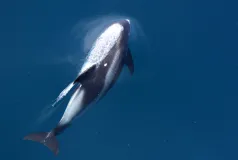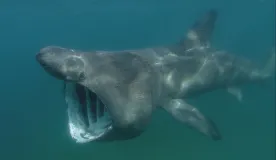Dogger Bank NCA
Brief description
Measuring approximately 18,000 km², Dogger Bank is the largest sand bank in the North Sea. It stretches more than 320 km from the continental shelf of the United Kingdom to the marine areas of the Netherlands, Germany and Denmark. The Dogger Bank NCA, which is located in the German part of this unique sandbank, covers 1,624 km² at depths of from 29 m to approximately 48 m.
At first glance, sandbanks that are covered by sea water all the time appear very uniform. But depending on the grain size of the sediments, the depth and the prevailing currents, they are home to a wide range of different biotic communities.
Rich plankton in the open water, millimetre-sized animals in the sand holes in the seabed, numerous mussels and worms, critically endangered snail species, echinoderms and crustaceans form a densely interwoven food web on Dogger Bank. Many of these provide the main source of food for a wide range of fish species. The name Dogger, which dates back to the Middle Ages, refers to the abundance of fish: it describes a fishing boat primarily used to catch cod. Dogger Bank is especially important for whales, dolphins and seals, all of which can be regularly spotted in large concentrations.
Pressures and management
In the Dogger Bank nature conservation area, the seabed has been severely damaged by activities such as bottom-contacting fishing – with fatal consequences for the unique ecological communities and the entire food web. Sandeel fishing on Dogger Bank takes away a key source of food for birds and marine mammals. Regulation of fishing in nature conservation areas in the EEZ requires agreement at EU level under the provisions of the Common Fisheries Policy (CFP). The proposed measures to regulate bottom-contacting fishing in the Dogger Bank NCA are currently the subject of a complicated, multi-phase approval process at both national and EU level.
At present, the Dogger Bank NCA is especially at risk from the ongoing expansion of offshore wind farms in and beyond German waters. There are also plans to erect wind farms in the Dogger Bank NCA itself. In addition, the wind farms planned in the vicinity of the nature conservation area and those that already exist in the waters of neighbouring states, together with their associated disturbances such as laying of cables and service traffic, pose an increasing threat – especially to birds and marine mammals. The BfN is working to ensure that any expansion of offshore wind farms can only occur in a nature-friendly way that takes account of prevailing conservation objectives.
Exploration for and extraction of hydrocarbons also poses a threat to sensitive species.
Facts and figures
| Name | FFH-Gebiet Doggerbank | EU Code | Größe |
|---|---|---|---|
| Dogger Bank | SAC | EU code: DE 1003-301 | 1.624 km² |
| Species and habitats | Size or figures (2024) | |
|---|---|---|
| Protected benthic habitats/area | Sandbanks (Habitats Directive habitat type; habitat type under section 30 of the Federal Nature Conservation Act (BnatSchG) | 1.624 km² |
Species-rich gravel, coarse sand and shell layers (section 30 of the Federal Nature Conservation Act (BnatSchG)) | 50 km² | |
| Species/number | Harbour porpoise (Phocoena phocoena) | approx. 16,500 in summer 2023 |
Minke whale (Balaenoptera acutorostrata) | Area used as feeding habitat | |
White-beaked dolphin (Lagenorynchus albirostris) | Area used as feeding habitat | |
Common seal (Phoca vitulina) | Area used as feeding habitat | |
Grey seal (Halichoerus grypus) | Area used as feeding habitat |
Character
The nature conservation area is characterised by high productivity and special ecological communities. Its fish diversity is of great importance for a wide range of marine mammals in particular and also for seabirds.
Different water masses come together on Dogger Bank, which rises significantly in contrast to its lower-lying surroundings. This is also reflected in the species distribution: cold-adapted species predominate in the north, warmth-preferring species in the south. The nature conservation area is home to a special offshore fine sandy bottom community not found in this composition in the other two North Sea NCAs.
The endangered species found in the area are primarily large and long-lived mollusc species, such as the ocean quahog (Arctica islandica) and the common whelk (Buccinum undatum). The endangered purple heart urchin (Spatangus purpureus) and the rare North Sea tube anemone (Synarachnactis lloydii) also occur on Dogger Bank.
Special circulatory patterns and the relatively shallow depth of Dogger Bank result in high biological production levels nearly down to the sea floor. These ensure good growing conditions for fish and thus a species-rich fish fauna. This mainly comprises gobies, sandeels, cod (Gadus morhua), whiting (Merlangius merlangus) and various flatfish species such as plaice (Pleuronectes platessa), sole (Solea solea) and European flounder (Platichthys flesus).
This fish diversity in turn serves as a source of food for other consumers, such as seabirds and marine mammals.
Harbour porpoise occur in large numbers in the protected area – a total of 16,500 were recorded in the summer of 2023. They use the area to forage for food, breed and rear their young. They are mainly attracted by the rich abundance of sandeels. Grey seals and common seals are also regularly spotted foraging for food and during migration. Basking sharks, minke whales and white-beaked dolphins can also be seen in the area.
During an expedition commissioned by the Federal Agency for Nature Conservation (BfN) as a snapshot survey in May 2024, a total of 111 harbour porpoise, 42 minke whales and 121 white-beaked dolphins were counted – more than ever before. A humpback whale was also sighted in the area for the first time. These sightings highlight the area’s unique character and highlight why its protection is so important. According to the International Union for Conservation of Nature (IUCN), the entire Dogger Bank is one of the world’s most important areas for the protection of marine mammals.






